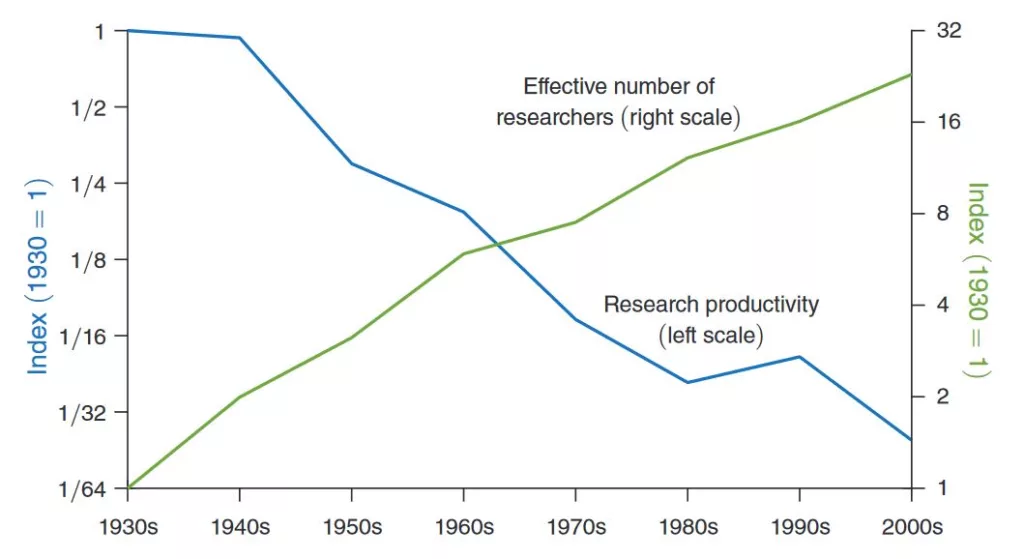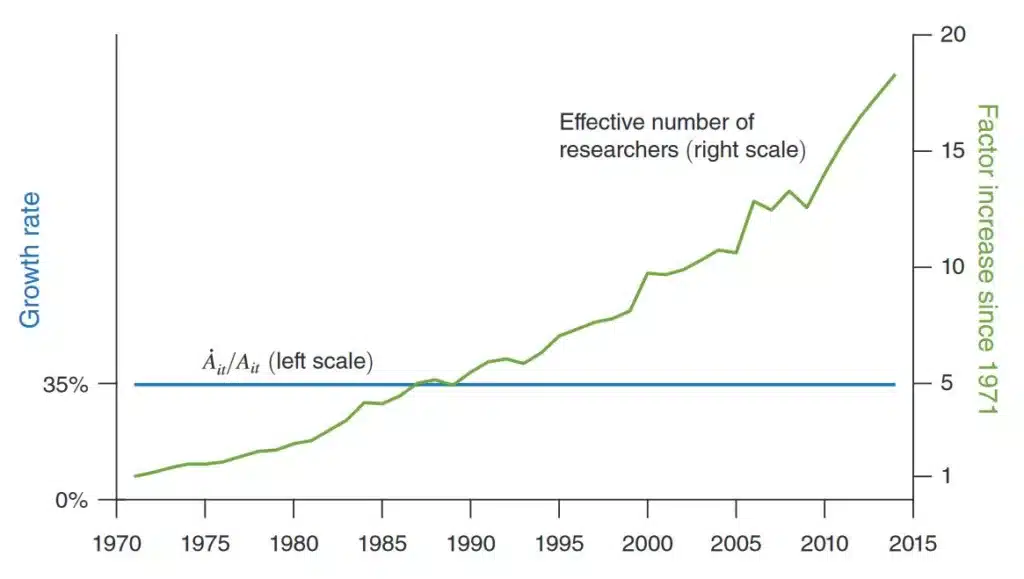Economic growth depends on the human capacity to propose innovations that increase our productivity. Since the early 2000s, this type of innovation has become rare. Whereas it took one generation (30 years) to double productivity (and therefore wealth) in the 20th century, it now takes 175 years. The major economic repercussions on our societies can explain this situation. However, Large Language Models (LLMs) offer new hope.
Contact the research institute IntoTheMinds
Inventions have less impact on growth than in the past
After the Second World War, our parents lived in blessed times. This reconstruction era saw the flowering of radical innovations that contributed to an unprecedented rise in living standards. In France, for example, innovations boosted productivity at an average annual rate of 2.5% between 1973 and 2003. Over 30 years, productivity has more than doubled. Between 1945 and 1975, the average annual rate was even 5%.
Today, however, we are witnessing a general slowdown. Productivity is no longer increasing in the same proportions. Between 2003 and 2023, average annual growth was just 0.4% in France and 0.6% in Europe. It would take 175 years to achieve a doubling.
Innovations no longer follow each other at the same pace. Our society can no longer produce the same technological breakthroughs to increase productivity. To paraphrase Robert Gordon, “Today’s innovations have less effect than in the past.”
All this, of course, reflects on our morale and on the direction our whole society is taking. Stagnation in well-being leads to frustration, leading to epiphenomena such as polarization.
A phased decline in productivity
The decline in productivity has occurred in fits and starts. The first break occurred in the mid-1970s, with;
- The widespread use of electrical appliances: manual tasks in Western countries had already been largely replaced by electrical aids.
- attaining maximum speeds for commercial transport: the average speed of airliners, for example, no longer increased significantly.
A second breakthrough came between 1980 and 2003, thanks to the personal computer. The latter first replaced the less efficient technologies that populated office spaces before becoming a window into the world thanks to the Internet. Since then, the business world has been waiting for a revolution. Nothing has happened in the world of work that has drastically increased productivity … until 2023 and the arrival of LLMs via ChatGPT. We’ll come back to this later.
But first, we need to look at the reasons for this stagnation. Why is it so difficult to propose breakthrough innovations? The answer is given by a 2020 research study that deserves to be highlighted.
The R&D effort to conduct Moore’s Law has been multiplied by 18 since the 1970s.
It’s getting harder and harder to produce innovative ideas.
This research was published in the American Economic Review in 2020 by a group of 4 researchers at Standford and MIT. Their pedigree puts them above suspicion regarding the quality of their work.
These researchers show that, whatever the field, productivity is increasing less rapidly than R&D effort. In other words, the number of researchers needed to conduct research is not constant. It only increases, which mechanically lowers R&D output. This is illustrated by the graph below, taken from the article in question. While the number of researchers has only increased since the 1930s, research productivity has only fallen.
The authors of the research give several concrete illustrations of this result in the fields of medicine, pharmaceutical research, and agriculture. But their illustration of Moore’s Law is easiest to understand.
Moore’s Law postulates that the number of transistors on the same surface doubles every 2 years. This corresponds to an annual increase of 35%. By measuring the R&D spending of companies involved in chip development since the 70s, researchers discovered that the number of researchers needed to guarantee this 35% annual growth was not constant. The R&D effort to conduct Moore’s Law has been multiplied by 18 since the 1970s (see graph below).
I’ll have to return to the results obtained in medicine, pharmaceuticals, and agriculture in another article. Here, the discoveries are even more marked, and the situation is much more negative.
Increasingly anecdotal innovations
The result of this difficulty in innovating is that the innovations proposed are increasingly anecdotal. Allow me to illustrate this paradox with an emblematic example. The iPhone.
I remember the presentation of the iPhone in 2007 with emotion. But what has happened since then?
Every year, Apple conducts an event to present its new iPhone. It’s gotten bigger, more powerful, heavier… but everything has stayed the same. Worse still, we’re now being served up innovations that are a real regression from the original vision, which was to get rid of the keyboard. At CES 2024, here’s what the tech world got excited about. An iPhone keyboard. Steve Jobs must be turning in his grave.
I could go on and on. The last 20 years have been paved with pseudo-revolutionary innovations. The CES shows in Las Vegas over the last 20 years have honored innovations that are anything but revolutionary. What have OLED screens, 3D TVs, 5G, 8K, smart watches, connected fridges… changed our lives? Nothing. Progress has conducted itself gradually until 2023.
The hope of LLMs (Large Language Models)
ChatGPT has been the only real revolution since smartphones. The BlackBerry, then the iPhone, had enabled us to exploit even the smallest “dead” moments in our day. We’ve become extensions of the Internet. ChatGPT has given us unprecedented power in the form of Large Language Models (LLMs). These algorithms, whose workings remain a mystery, promise to revolutionize the world of work. Certain tasks will finally be able to be accelerated or even eliminated.
Of course, this revolution has some people panicking. Generative AI will replace us all. That’s the usual refrain. But those who say this forget that 70% of jobs provide local goods or services. They have nothing to fear from content production, which LLMs will simplify.
So, let’s embrace the generative AI revolution for what it is: the promise of a new leap in productivity.
Posted in Entrepreneurship, Research.

